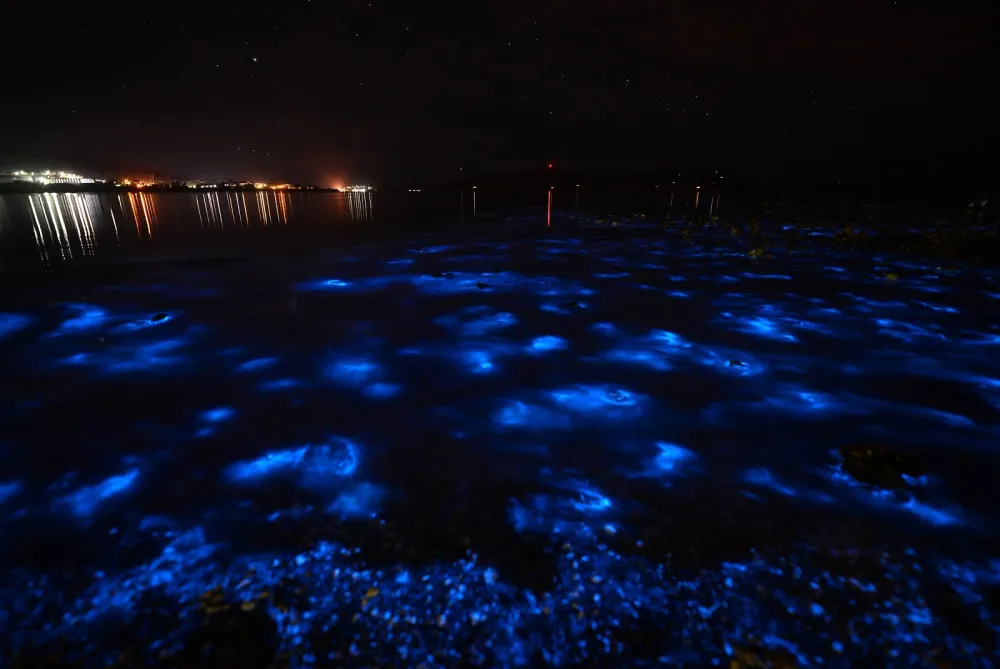The Best Time to Go to Puerto Rico’s Bioluminescent Bays

Puerto Rico’s startling bioluminescent bays are some of the most scenic places to visit on the island, and unlike other bays in the world, these can be visited year-round. Depending on which bio bay you visit — Laguna Grande, Mosquito Bay, or La Parguera — you can enjoy snorkeling, kayaking, and even swimming among the bioluminescence.
Bio bays are characterized by a blue-green glow caused by the presence of millions of dinoflagellates, single-celled organisms that produce the light when stirred by movement. There are a few factors that will affect how bright the bays are during your visit, but one of the most important is the phase of the moon. That’s right — you should plan your trip to a bio bay around the lunar calendar!
The best time to visit a bioluminescent bay is around a new moon, when there is little to no moonlight, making the sky extra dark so you can get a better view of the brilliant glow. There are, however, a few more considerations to keep in mind when planning your visit. Read on to find the best time to visit one of Puerto Rico’s bio bays!
Best Time of the Year to Visit
While the bio bays have some bioluminescence year-round, the best time of the year to visit them is during the dry season, from December to mid-April. Heavy rainfall can cloud the water and make it harder to see the glow from the dinoflagellates. Because of this, the rainy season (from June to November) is not an ideal time to visit a bio bay.
During the dry season, the weather is practically perfect in Puerto Rico, and you’ll have the best chance to see the bioluminescent bays at peak brightness. However, the ideal weather also means that this is the most popular time to visit Puerto Rico, so the island will be busier in general, you’ll face higher flight and accommodation costs, and there will probably be more people exploring the bio bays along with you.
To avoid the busiest time of the season, steer clear of mid-March, which is when a lot of families with children and college students travel for Spring Break. There are typically fewer crowds in February and April, making them the best months to visit during the dry season.
Read more about timing your visit in our island guide!

Best Time of the Month to Visit
Like we said earlier, the best time to visit a bio bay is during a new moon when the sky is darker and the bioluminescence is more prominent. You might not think that moonlight could make that big of a difference, but if the moon is too bright, it can dim the effect of the dinoflagellates. Mosquito Bay is widely known to be the brightest of the islands’ three bio bays, but even this one is affected by the light of the moon.
For optimal brightness, pull up a lunar calendar next to the tour calendar so you can select the best day for your bio bay tour. You can use an online lunar phase calendar or an app on your smartphone. Try to plan your tour either on the night of the new moon or two to three days before or after the new moon to see the bays at their brightest.
Other Factors That Affect Brightness
The tide and temperature of the water can also affect the concentrations of dinoflagellates and hence the brightness of the bays. Most tour operators won’t take you out to the bays if the brightness is under 30%, and they’ll get in touch with you to let you know. If you’re not sure, give them a call a day or two before your tour to confirm that they expect the glow to be above this level during your visit.
Like any natural wonder, environmental factors and natural disasters affect bioluminescent bays, as was shown after Hurricane María in 2017. After the hurricane, Mosquito Bay went dark, the rain and high winds pushing the dinoflagellates out to sea and harming the mangroves that provide nutrients for them. The dinoflagellates returned, bringing back their signature glow, but it was a stark reminder that these beautiful parts of the world might not last forever. This is all the more reason to visit a bio bay on your next vacation.
Explore a variety of bio bay tours and more in Puerto Rico.
